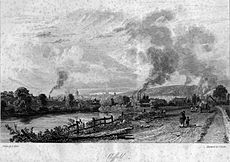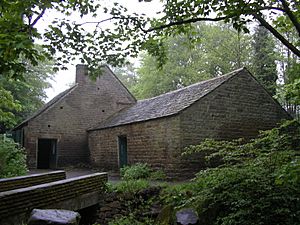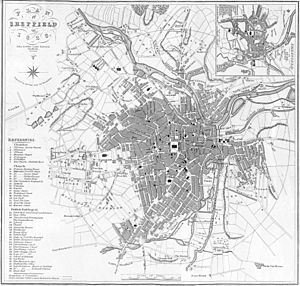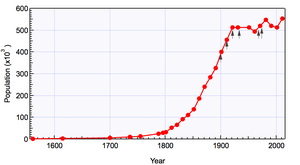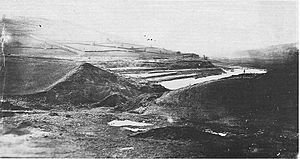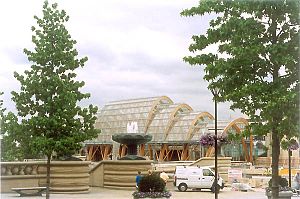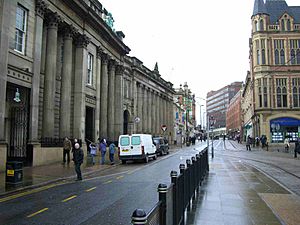History of Sheffield facts for kids
The history of Sheffield, a city in South Yorkshire, England, began with a small settlement next to the River Sheaf around 500 to 1000 AD. People have lived in the Sheffield area since the last ice age. However, the settlements that make up the city today didn't really grow until the Industrial Revolution.
After the Norman conquest of England, Sheffield Castle was built to control the Saxon villages. Sheffield then grew into a small town, about the size of today's Sheffield City Centre. By the 1300s, Sheffield was famous for making knives. By 1600, thanks to the Company of Cutlers in Hallamshire, it became the second most important place for making cutlery in England, after London.
In the 1740s, a Sheffield resident named Benjamin Huntsman improved the crucible steel process, which made much better quality steel. Around the same time, Sheffield plate, a way to put a thin layer of silver on copper, was invented. These industries helped Sheffield grow very quickly. The town officially became a borough in 1843 and a city in 1893.
Sheffield remained a big industrial city through the first half of the 1900s. But after the 1973 oil crisis and changes in how steel was made, many steelworks closed from the 1970s onwards. The city started projects in the late 1980s to bring in new types of businesses. Today, Sheffield is a hub for banking and insurance, with companies like HSBC and Santander having offices there. It has also become a place for new digital companies, employing many people in that sector.
Contents
Ancient History of Sheffield
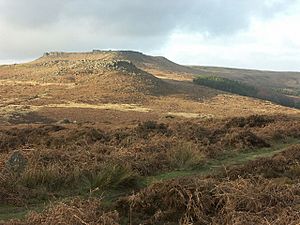
The oldest signs of people living in the Sheffield area were found at Creswell Crags. Tools and cave art found there are at least 12,800 years old, from the late Stone Age. Other ancient remains include a Mesolithic "house" (a circle of stones) from around 8000 BC, found at Deepcar.
During the Bronze Age (about 1500 BC), groups of people settled here. They built many stone circles, which you can still see on Moscar Moor and Froggatt Edge.
Iron Age Settlements
During the British Iron Age, the Sheffield area was the southern part of the land belonging to a Pennine tribe called the Brigantes. Around 500 BC, this tribe likely built the hill fort at Wincobank, in northeast Sheffield. Other Iron Age hill forts are Carl Wark to the southwest and one at Scholes Wood. The rivers Sheaf and Don might have been the border between the Brigantes and another tribe called the Corieltauvi.
Roman Times in Sheffield
The Romans came to Britain in AD 43. By 51 AD, the Brigantes were working with Rome, and by the 70s, Rome directly ruled them. Not many Roman remains have been found in Sheffield. A small Roman road probably ran through the city, connecting forts at Templeborough and Brough-on-Noe.
In 1761, Roman tablets were found in the Rivelin Valley. These included a grant of citizenship to a Roman soldier. Small Roman coins have also been found across Sheffield. Roman burial urns were found near Sheffield Cathedral. This, and the name of an old lane nearby (Campo Lane), made some people think there might have been a Roman camp there. However, it's unlikely that the settlement that became Sheffield existed then. In 2011, a large Roman farm or 'villa' from the 1st or 2nd century AD was found at Whirlow Hall Farm.
After the Romans left, the Sheffield area might have been the southern part of the Celtic kingdom of Elmet. The rivers Sheaf and Don formed part of its border with the kingdom of Mercia. Slowly, Anglian settlers moved west. The word Wales in place names like Wales and Waleswood comes from a Germanic word meaning "foreigners," used by Anglo-Saxons for the native Britons.
How Sheffield Got Its Name

The name Sheffield comes from Old English. It's named after the River Sheaf. The river's name means "to divide or separate." Field means a clearing in a forest. So, Sheffield was likely an Anglo-Saxon settlement in a clearing by where the rivers Sheaf and Don meet. This happened between the 500s and early 800s.
Many other areas in Sheffield that were settled during this time have names ending in ley (meaning a forest clearing) or ton (meaning an enclosed farm). Examples include Heeley, Longley, Norton, and Tinsley.
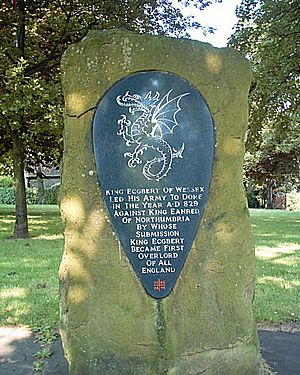
The oldest proof of this settlement is a stone cross shaft from the early 800s, found in Sheffield in the 1800s. It's now in the British Museum.
An old document from 829 AD, the Anglo-Saxon Chronicle, says that King Eanred of Northumbria surrendered to King Egbert of Wessex at Dore (now a Sheffield suburb). This event made Egbert the first Saxon king to claim to rule all of England.
In the late 800s, Viking settlers arrived and set up the Danelaw. Villages they founded often end in thorpe, meaning a farm. Examples in Sheffield are Grimesthorpe and Hackenthorpe. By 918, the Danes south of the Humber had submitted to Edward the Elder.
In 937, Viking, Scottish, and Cumbrian armies invaded England. King Æthelstan's army defeated them at the Battle of Brunanburh. No one knows exactly where Brunanburh was, but some historians think it was between Tinsley and Brinsworth.
The Domesday Book of 1086, made after the Norman Conquest of 1066, first mentions the Sheffield area as the manor of "Hallun" (or Hallam). This book was ordered by William the Conqueror to find out the value of lands in England.
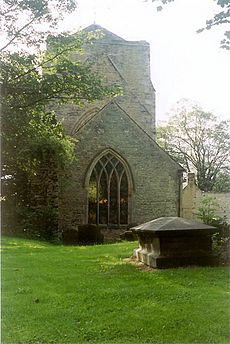
The Domesday Book mentions Sheffield twice, as Escafeld and Scafeld. Historians think Scafeld (pronounced Shaffeld) is closer to the true name.
After Roger de Busli, the manor of Hallamshire went to William de Lovetot. He founded several churches, including Sheffield's parish church. He also built the first wooden Sheffield Castle, which helped the town grow.
Beauchief Abbey was also founded around this time, dedicated to Saint Mary and Saint Thomas Becket.
Medieval Sheffield
The de Furnival family took over the manor of Hallamshire around 1204. The fourth Furnival lord, Thomas de Furnival, supported Simon de Montfort in the Second Barons' War. Because of this, in 1266, a group of barons destroyed Sheffield, burning the church and castle.
A new stone castle was built over the next four years. A new church was also built around 1280. In 1295, Thomas de Furnival's son became the first Lord Furnivall. On November 12, 1296, King Edward I allowed a market to be held in Sheffield every Tuesday. Then, on August 10, 1297, Lord Furnival made Sheffield a free borough.
The Sheffield Town Trust was set up in 1297. Lord Furnival gave land to Sheffield's freeholders in exchange for a yearly payment. The Common Burgery managed these lands. The Burgery was originally public meetings of all freeholders, who elected a Town Collector.
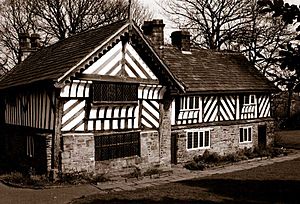
The Furnivals held Sheffield for two more generations. Then, in 1406, it passed to John Talbot, the first Earl of Shrewsbury.
In 1430, the 1280 Sheffield parish church was rebuilt. Parts of this new church are still standing today and form the core of Sheffield Cathedral. Other old buildings from this time include the Old Queen's Head pub (around 1480) and Bishops' House and Broom Hall (around 1500).
The fourth Earl of Shrewsbury, George Talbot, lived in Sheffield. He built the Manor Lodge outside town around 1510. In 1569, George Talbot, the sixth Earl, was put in charge of Mary, Queen of Scots. Mary was seen as a threat by Queen Elizabeth I.
Talbot brought Mary to Sheffield in 1570. She spent most of the next 14 years held captive in Sheffield Castle and nearby buildings. The Turret House, an Elizabethan building, might have been built for her. During the English Civil War, Sheffield changed hands several times. It finally fell to the Parliamentarians, who tore down the Castle in 1648.
The Industrial Revolution brought large-scale steel making to Sheffield in the 1700s. Much of the old medieval town was replaced by Georgian and Victorian buildings. Today, parts of Sheffield's city centre have been rebuilt, but some old buildings remain.
Sheffield's Industrial Growth
Sheffield was perfect for water-powered industries. It had fast rivers and streams, surrounded by hills with coal, iron ore, and stone for grindstones. Water wheels were first used for grinding corn, but many were changed to make blades. By the 1300s, Sheffield was known for knives.
Ay by his belt he baar a long panade,
And of a swerd ful trenchant was the blade.
A joly poppere baar he in his pouche;
Ther was no man, for peril, dorste hym touche.
A Sheffeld thwitel baar he in his hose.
Round was his face, and camus was his nose;—Geoffrey Chaucer, The Reeve's Tale from The Canterbury Tales
By 1600, Sheffield was the main place for cutlery outside London. In 1624, The Company of Cutlers in Hallamshire was formed to manage the trade. You can see examples of old water-powered workshops at the Abbeydale Industrial Hamlet and Shepherd Wheel museums.
About a century later, Daniel Defoe wrote in his book A tour thro' the whole island of Great Britain:
This town of Sheffield is very populous and large, the streets narrow, and the houses dark and black, occasioned by the continued smoke of the forges, which are always at work: Here they make all sorts of cutlery-ware, but especially that of edged-tools, knives, razors, axes, &. and nails; and here the only mill of the sort, which was in use in England for some time was set up, (viz.) for turning their grindstones, though now 'tis grown more common.
Here is a very spacious church, with a very handsome and high spire; and the town is said to have at least as many, if not more people in it than the city of York.
In the 1740s, Benjamin Huntsman, a clock maker, invented a way to make better quality steel called crucible steel. Around the same time, Thomas Boulsover invented Sheffield plate. This was a way to fuse a thin sheet of silver onto a copper ingot. It was first used for silver buttons, then for kitchenware. Eventually, cheaper electroplate replaced it in the 1840s. In 1773, Sheffield got a silver assay office. Later, Britannia metal, a silver-like alloy, was invented there.
Huntsman's process was replaced in 1856 by Henry Bessemer's Bessemer converter. Bessemer built his own steelworks in Sheffield because other steelmakers didn't want to use his new system. One of Bessemer's converters is still at Sheffield's Kelham Island Museum.
In 1857, Sheffield Football Club was formed. It is the world's oldest association football club. Many other football teams quickly started in the area.
Stainless steel was discovered by Harry Brearley in 1912 in Sheffield. His successor, Dr William Hatfield, patented '18-8 stainless steel' in 1924. This is still a very common type of stainless steel today.
These inventions made Sheffield famous worldwide for cutlery. The town's population grew very fast. In 1736, Sheffield had about 7,000 people. By 1801, it had 60,000, and by 1901, it reached 451,195.
This growth led to changes in how the town was run. Before 1818, different groups managed things like streets and bridges. In 1818, the Sheffield Improvement Act 1818 created a Commission to improve the city. In 1832, Sheffield got its own Parliamentary borough for political representation. A municipal borough was formed in 1843, and it became a "City" in 1893.
From the mid-1700s, many public buildings were built. The old Town Hall and the current Cutlers' Hall were major works of the 1800s. The city's water supply was improved by the Sheffield Waterworks Company, who built reservoirs. However, parts of Sheffield were destroyed when the Dale Dyke dam collapsed on March 11, 1864. This caused the Great Sheffield Flood.
Sheffield's transport also improved. In the 1700s, turnpike roads were built connecting Sheffield to other towns. In 1774, a wooden tramway was laid at a colliery. The Sheffield Canal opened in 1819 for large-scale transport.
Railways followed, with the Sheffield and Rotherham Railway in 1838. The Sheffield Tramway started in 1873 with horse trams. Due to narrow medieval roads, trams were first banned from the town centre. Road widening projects in the late 1800s helped.
Sheffield became a major centre for trade union organization. In the 1860s, conflicts between workers and factory owners led to the 'Sheffield Outrages', with explosions and murders by union members. The Sheffield Trades Council helped found the Trades Union Congress (TUC) in 1866.
Sheffield in the 20th and 21st Centuries
In 1914, Sheffield became a diocese of the Church of England, and its parish church became a cathedral. During the First World War, the Sheffield City Battalion suffered heavy losses. Sheffield itself was bombed by a German zeppelin.
The economic downturn of the 1930s ended as the Second World War approached. Sheffield's steel factories made weapons and ammunition. Because of this, the city was a target for bombing raids. There were 16 raids, but the worst damage happened on December 12 and 15, 1940, known as the Sheffield Blitz. More than 660 people died, and many buildings were destroyed.
After the war, the 1950s and 1960s saw big changes. The old tramway closed, and new roads like the Inner Ring Road were built. Many old slums were cleared and replaced with new housing, like the Park Hill flats.
Sheffield's traditional industries, like manufacturing, declined during the 1900s.
The Meadowhall shopping centre opened in 1990 on an old steelworks site. It created jobs but also sped up the decline of the city centre. Efforts to rebuild the city started when it hosted the 1991 World Student Games. New sports facilities like the Sheffield Arena and Don Valley Stadium were built. Sheffield also started building a new tram system in 1992.
Since 1995, the Heart of the City Project has improved the city centre. The Peace Gardens were redone in 1998, the Millennium Gallery opened in 2001, and the Winter Garden opened in 2003. Other projects, called Sheffield One, aim to improve the whole city centre.
On June 25, 2007, flooding caused millions of pounds of damage and two deaths in the city.
In July 2013, the Sevenstone project, which aimed to rebuild a large part of the city centre, was delayed. The city council is looking for new partners for the plan. In 2014, the council and Sheffield University offered empty shops for free to small businesses to help the city centre.
Images for kids
-
The Bishops' House.
-
Sheffield Winter Gardens (2012)
See also
 In Spanish: Historia de Sheffield para niños
In Spanish: Historia de Sheffield para niños


